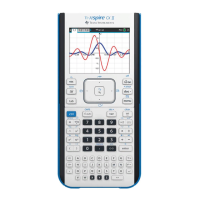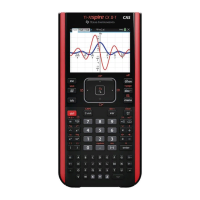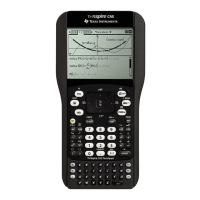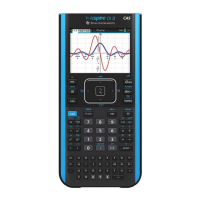TI-Nspire™ Reference Guide 85
rk23()
Catalog
>
rk23(Expr, Var , depVar, {Va r 0 , Va r Ma x }, depVar0, Var St ep
[, diftol]) ⇒ matrix
rk23(SystemOfExpr, Var , ListOfDepVars, {Va r0 , Va rM ax },
ListOfDepVars0, Va rS te p [, diftol])
⇒ matrix
rk23(ListOfExpr, Var , ListOfDepVars, {Va r0 , Va rM ax },
ListOfDepVars0, Va r St e p [, diftol])
⇒ matrix
Uses the Runge-Kutta method to solve the system
= Expr(Var , depVar)
with depVar(Va r 0 )=depVar0 on the interval [Va r0 ,Va r M a x]. Returns a
matrix whose first row defines the Va r output values as defined by
Va rSt ep . The second row defines the value of the first solution
component at the corresponding Va r values, and so on.
Expr is the right hand side that defines the ordinary differential
equation (ODE).
SystemOfExpr is a system of right-hand sides that define the system
of ODEs (corresponds to order of dependent variables in
ListOfDepVars).
ListOfExpr is a list of right-hand sides that define the system of ODEs
(corresponds to order of dependent variables in ListOfDepVars).
Va r is the independent variable.
ListOfDepVars is a list of dependent variables.
{Va r0 , Var M ax } is a two-element list that tells the function to
integrate from Va r 0 to Va r Ma x.
ListOfDepVars0 is a list of initial values for dependent variables.
If Va rSt ep evaluates to a nonzero number: sign(Va rS te p) =
sign(Va rM a x-Va r0 ) and solutions are returned at Va r 0 +i*Va rS t e p for
all i=0,1,2,… such that Va r 0 +i*Va r St e p is in [var0,Va r Ma x] (may not
get a solution value at Va r Ma x ).
if Va rSt ep evaluates to zero, solutions are returned at the "Runge-
Kutta" Va r values.
diftol is the error tolerance (defaults to 0.001).
Differential equation:
y'=0.001*y*(100-y) and y(0)=10
To see the entire result, press £ and then use ¡ and ¢ to
move the cursor.
Same equation with diftol set to 1.E•6
System of equations:
with y1(0)=2 and y2(0)=5
root()
Catalog
>
root(Va lu e ) ⇒ root
root(Va lu e 1, Va lu e2 ) ⇒ root
root(Va lu e ) returns the square root of Val u e .
root(Va lu e 1, Va lu e2 ) returns the Va lu e 2 root of Val ue 1. Va lu e1
can be a real or complex floating point constant or an integer or
complex rational constant.
Note: See also Nth root template, page 1.
rotate()
Catalog
>
rotate(Integer1[,#ofRotations]) ⇒ integer
Rotates the bits in a binary integer. You can enter Integer1 in any
number base; it is converted automatically to a signed, 64-bit binary
form. If the magnitude of Integer1 is too large for this form, a
symmetric modulo operation brings it within the range. For more
information, see 4Base2, page 12.
In Bin base mode:
To see the entire result, press £ and then use ¡ and ¢ to
move the cursor.
ep
a
Vard
-------------------
